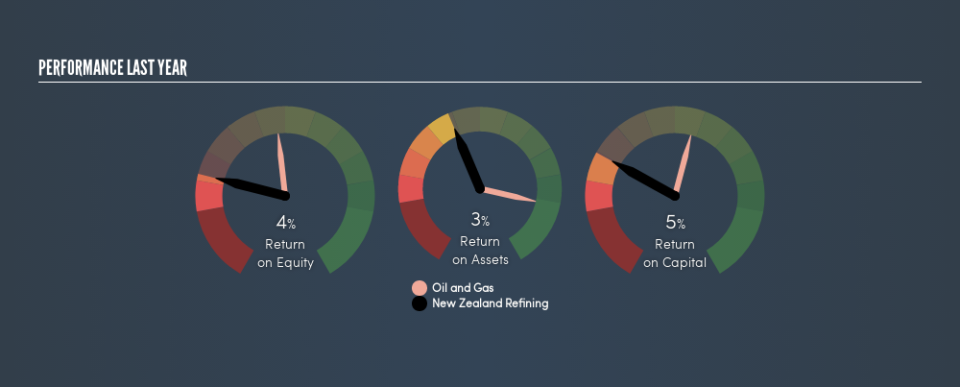The New Zealand Refining Company Limited (NZSE:NZR) Might Not Be A Great Investment

Today we'll evaluate The New Zealand Refining Company Limited (NZSE:NZR) to determine whether it could have potential as an investment idea. Specifically, we'll consider its Return On Capital Employed (ROCE), since that will give us an insight into how efficiently the business can generate profits from the capital it requires.
Firstly, we'll go over how we calculate ROCE. Second, we'll look at its ROCE compared to similar companies. Finally, we'll look at how its current liabilities affect its ROCE.
Return On Capital Employed (ROCE): What is it?
ROCE measures the amount of pre-tax profits a company can generate from the capital employed in its business. All else being equal, a better business will have a higher ROCE. In brief, it is a useful tool, but it is not without drawbacks. Author Edwin Whiting says to be careful when comparing the ROCE of different businesses, since 'No two businesses are exactly alike.'
How Do You Calculate Return On Capital Employed?
The formula for calculating the return on capital employed is:
Return on Capital Employed = Earnings Before Interest and Tax (EBIT) ÷ (Total Assets - Current Liabilities)
Or for New Zealand Refining:
0.047 = NZ$54m ÷ (NZ$1.4b - NZ$226m) (Based on the trailing twelve months to June 2019.)
Therefore, New Zealand Refining has an ROCE of 4.7%.
See our latest analysis for New Zealand Refining
Does New Zealand Refining Have A Good ROCE?
ROCE can be useful when making comparisons, such as between similar companies. Using our data, New Zealand Refining's ROCE appears to be significantly below the 10.0% average in the Oil and Gas industry. This performance is not ideal, as it suggests the company may not be deploying its capital as effectively as some competitors. Regardless of how New Zealand Refining stacks up against its industry, its ROCE in absolute terms is quite low (especially compared to a bank account). It is likely that there are more attractive prospects out there.
We can see that , New Zealand Refining currently has an ROCE of 4.7%, less than the 14% it reported 3 years ago. So investors might consider if it has had issues recently. The image below shows how New Zealand Refining's ROCE compares to its industry, and you can click it to see more detail on its past growth.
When considering this metric, keep in mind that it is backwards looking, and not necessarily predictive. Companies in cyclical industries can be difficult to understand using ROCE, as returns typically look high during boom times, and low during busts. This is because ROCE only looks at one year, instead of considering returns across a whole cycle. We note New Zealand Refining could be considered a cyclical business. What happens in the future is pretty important for investors, so we have prepared a free report on analyst forecasts for New Zealand Refining.
New Zealand Refining's Current Liabilities And Their Impact On Its ROCE
Current liabilities are short term bills and invoices that need to be paid in 12 months or less. Due to the way the ROCE equation works, having large bills due in the near term can make it look as though a company has less capital employed, and thus a higher ROCE than usual. To check the impact of this, we calculate if a company has high current liabilities relative to its total assets.
New Zealand Refining has total liabilities of NZ$226m and total assets of NZ$1.4b. Therefore its current liabilities are equivalent to approximately 16% of its total assets. This is a modest level of current liabilities, which will have a limited impact on the ROCE.
The Bottom Line On New Zealand Refining's ROCE
New Zealand Refining has a poor ROCE, and there may be better investment prospects out there. Of course, you might find a fantastic investment by looking at a few good candidates. So take a peek at this free list of companies with modest (or no) debt, trading on a P/E below 20.
If you are like me, then you will not want to miss this free list of growing companies that insiders are buying.
We aim to bring you long-term focused research analysis driven by fundamental data. Note that our analysis may not factor in the latest price-sensitive company announcements or qualitative material.
If you spot an error that warrants correction, please contact the editor at editorial-team@simplywallst.com. This article by Simply Wall St is general in nature. It does not constitute a recommendation to buy or sell any stock, and does not take account of your objectives, or your financial situation. Simply Wall St has no position in the stocks mentioned. Thank you for reading.

 Yahoo Finance
Yahoo Finance 
